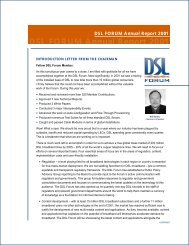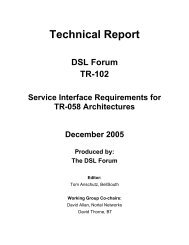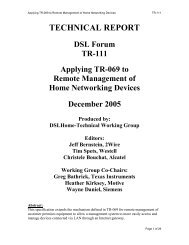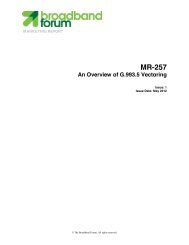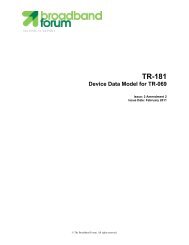MPLS in Mobile Backhaul Networks Framework and Requirements ...
MPLS in Mobile Backhaul Networks Framework and Requirements ...
MPLS in Mobile Backhaul Networks Framework and Requirements ...
Create successful ePaper yourself
Turn your PDF publications into a flip-book with our unique Google optimized e-Paper software.
<strong>MPLS</strong> <strong>in</strong> <strong>Mobile</strong> <strong>Backhaul</strong> <strong>Networks</strong> <strong>Framework</strong> <strong>and</strong> <strong>Requirements</strong> Technical Specification IP/<strong>MPLS</strong> Forum 20.0.0<br />
___________________________________________________________________________________<br />
For example, the MASG derives the clock from a site <strong>and</strong> sends frequency distribution dedicated<br />
frames across the <strong>MPLS</strong> network. The CSGs receive the frames, recover the orig<strong>in</strong>al clock <strong>and</strong><br />
distribute the clock to the BTSs/NodeBs over the legacy <strong>in</strong>terface (e.g., TDM). As an alternative<br />
the CSG clock recovery function might be embedded <strong>in</strong>to the base-station <strong>and</strong> there is no TDM<br />
<strong>in</strong>terface.<br />
Frequency distribution relies on two different packet-based methods:<br />
o Time-stamp<strong>in</strong>g methods (e.g. IEEE 1588v2, NTP)<br />
o Circuit emulation PW methods (e.g. used for data <strong>and</strong> synchronization, or<br />
dedicated to synchronization)<br />
� Scenario III: St<strong>and</strong>-alone clock distribution device. Similar to scenario II but uses a st<strong>and</strong>-alone<br />
clock distributor (e.g. IEEE 1588v2 gr<strong>and</strong>master), located somewhere <strong>in</strong> the network, to<br />
distribute clock over the <strong>MPLS</strong> transport network.<br />
Note: Hybrid scenarios where a few of the above approaches are comb<strong>in</strong>ed together are also possible.<br />
7.11.1.2 Time distribution<br />
There are three possible scenarios of time distribution (when needed) <strong>in</strong> mobile networks us<strong>in</strong>g <strong>MPLS</strong><br />
transport.<br />
� Scenario I: Us<strong>in</strong>g external synchronization distribution means (e.g., GPS).<br />
� Scenario II: End-to-end time distribution. The elements that participate <strong>in</strong> the time distribution<br />
<strong>and</strong> recovery are the RAN equipment (e.g., RNC, Node-Bs or BSC,), MASG <strong>and</strong> the CSG. The<br />
other network elements <strong>in</strong> the IP/<strong>MPLS</strong> network transparently transport the synchronization<br />
<strong>in</strong>formation with appropriate QoS. However the PDV <strong>in</strong>troduced by the packet network as well as<br />
the asymmetry <strong>in</strong> the network are fundamental characteristics impact<strong>in</strong>g the performance of the<br />
time synchronization delivered.<br />
For example, the MASG derives the time from a site <strong>and</strong> sends time distribution dedicated frames<br />
(which might be the same frames used for frequency distribution) across the <strong>MPLS</strong> network. The<br />
CSGs receive the frame, recover the orig<strong>in</strong>al time <strong>and</strong> distributes it to the BTSs/NodeBs. An<br />
alternative is that the CSG clock recovery function might be embedded <strong>in</strong>to the base-station<br />
� Scenario III: St<strong>and</strong>-alone time distribution device. Similar to scenario II but uses a st<strong>and</strong>-alone<br />
time distributor (e.g., IEEE 1588v2 gr<strong>and</strong>master), located somewhere <strong>in</strong> the network, to distribute<br />
time over the <strong>MPLS</strong> transport network. These use packet based methods that require the<br />
allocation of special functions <strong>in</strong> the transport network <strong>in</strong> order to reduce the impacts from PDV<br />
<strong>and</strong> <strong>in</strong>crease the quality of the time delivered (e.g., IEEE 1588v2 transparent clocks).<br />
October 2008 Page 36








